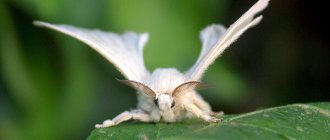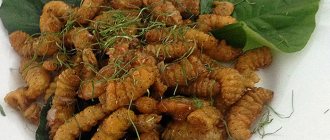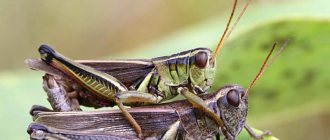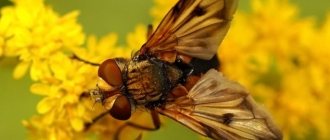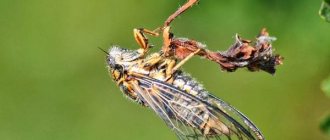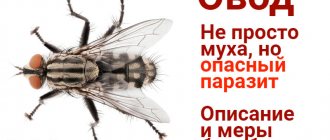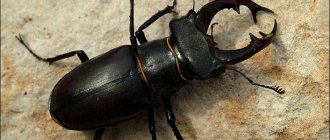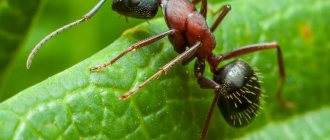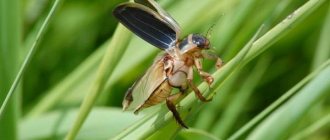The silkworm is a species of butterfly that became the basis for the development of sericulture, the production of natural fabrics based on threads that in nature are woven by caterpillars that feed on the leaves of the mulberry tree (mulberry). According to classification criteria, it belongs to the kingdom of Animals, phylum Arthropods, class Insects, order Lepidoptera, family True silkworms, genus Bombix, according to the Latin nomenclature Bombix mori (L.). The species was described by Carl Linnaeus in 1758.
The natural distribution area is eastern Asia, northern China, Primorye. It was domesticated by humans, according to various sources, from one thousand to five thousand years ago. Currently not found in the wild.
Description and features
The silkworm goes through four stages in its development. First the eggs are laid. The laying of eggs is called grena. Larvae or mulberry worms emerge from the eggs. The larvae pupate. Next, the last, most amazing phase of transformation occurs - the pupa reincarnates into a butterfly (moth, moth).
The silkworm in the photo most often appears in the form of its winged essence, that is, a moth. It is rather nondescript, painted smoky white. The wings have a standard appearance for Lepidoptera, consist of 4 segments, and spread approximately 6 cm.
The pattern on the wings is simple: a large web of longitudinal and transverse lines. The silkworm butterfly is quite furry. She has a furry body, fuzzy legs and large hairy antennae (antennae).
The silkworm has a feature associated with long-term domestication. The insect has completely lost the ability to take care of itself: butterflies are not able to fly, and voracious caterpillars do not try to find food when they are hungry.
The origin of the silkworm has not been reliably established. The domesticated form is believed to have originated from the wild silkworm. The free-living silkworm butterfly is smaller than the domesticated one. It is capable of flight, and the caterpillar independently devastates thickets of mulberry bushes.
Natural enemies
In the wild, the insect is a diet for:
- birds;
- insectivores;
- parasitic insects.
Insectivores and birds consume adults and caterpillars. The most dangerous are considered to be tahins and hedgehogs . The hedgehog lays eggs inside or on the worm. Dangerous larvae develop and kill the silkworm. A surviving infected individual produces offspring that are already sick.
Tahini flies.
Pebrine disease poses a mortal threat. It is caused by pathogenic microorganisms. But modern silkworm breeders manage to cope with the pathogen.
Kinds
The silkworm is included in the biological classification under the name Bombyx mori. It is part of the Bombycidae family, whose name is interpreted as “true silkworms.”
The family is very extensive, consisting of 200 species of butterflies. Several varieties are known quite widely. They are united by one feature - the larvae of these insects create cocoons from thin, strong threads.
1. The wild silkworm is the closest relative of the domesticated butterfly. Possibly the original species from which it descended. Lives in the Far East. From the Ussuri region to the southern reaches of the Korean Peninsula, including China and Taiwan.
2. Gypsy moth - not a direct relative of the silkworm, but is often mentioned when listing varieties of silkworm butterflies. Belongs to the Volnyanka family. Distributed in Eurasia, recognized as a pest in North America.
3. Siberian silkworm - distributed in Asia, from the Urals to the Korean Peninsula. Member of the cocoon-worm family. It feeds on the needles of all types of evergreen trees.
4. Ringed silkworm - lives in European and Asian forests. Caterpillars of this species eat leaves of birch, oak, willow, and other trees, including fruit trees. Recognized as a pest.
5. Ailanthus silkworm - silk is obtained from it in India and China. This butterfly has never been domesticated. Found in Indochina and the Pacific Islands. There is a small population in Europe, where the food source, the ailanthus tree, grows.
6. Assamese Silkworm - This variety of silkworm is used in India to produce a fabric called "muga", which means "amber". The main place of production of this rare silk is the Indian province of Assam.
7. Chinese oak silkworm - threads obtained from the cocoons of this insect are used to make chesuchi - durable, lush silk. The production of this fabric was established relatively recently - only 250 years ago, in the 18th century.
8. Japanese oak silkworm - used in sericulture for 1000 years. The resulting thread is not inferior in strength to other types of silk, but surpasses all others in elasticity.
9. Castor silkworm - lives in Hindustan and Indochina. Castor bean leaves are the main and only food item. In India, this insect is used in the production of 'eri' or 'eri' silk. This fabric is somewhat inferior in quality to traditional silk.
The most important butterfly and caterpillar in the vast company of silkworms is the domesticated silkworm. For thousands of years, people have been observing and selecting butterflies - the primary source of high-quality thread and fabric.
There was a division into groups of breeds on a territorial basis.
- Chinese, Korean and Japanese.
- South Asian, Indian and Indo-Chinese.
- Persian and Transcaucasian.
- Central Asian and Asian Minor.
- European.
Each group differs from the others in the morphology of the butterfly, grenade, worm and cocoon. The ultimate goal of breeding is the quantity and quality of thread that can be obtained from the cocoon. Breeders distinguish three categories of silkworm breeds:
- Monovoltine - breeds that produce one generation per year.
- Bivoltine - breeds that produce offspring twice a year.
- Multivoltine - breeds that breed several times a year.
Monovoltine breeds of domesticated silkworms manage to cover the path of one generation in a calendar year. These breeds are cultivated in countries with relatively cool climates. Most often these are European countries.
Throughout the winter period, egg laying is in a state of inhibition, with physiological processes proceeding slowly. Revival and fertilization occurs with warming, in the spring. Winter diapause reduces the rate of offspring production to a minimum.
In countries where the climate is warmer, bivoltine breeds are more popular. Precocity is achieved by reducing some other qualities. Bivoltine butterflies are smaller than monovoltine ones. The quality of the cocoon is somewhat lower. Multivoltine silkworm breeding occurs exclusively on farms located in tropical regions.
The egg laying is fully developed in 8-12 days. This allows you to harvest cocoons up to 8 times a year. But these breeds are not particularly popular. The leading position is occupied by monovoltine and bivoltine varieties of silkworm. They provide the highest quality final product.
What harm does an insect cause?
It should be remembered that each insect brings a certain benefit to green spaces. The pine cocoon moth, which can be called a forest orderly, is no exception. Its caterpillars primarily eat old needles on diseased and weakened trees.
When the population becomes too numerous, the pine cocoon moth turns into an extremely dangerous pest of pine forests.
The greatest damage to forestry is caused by cocoon moth caterpillars, which eat needles at all stages of their development and especially intensively after wintering, from early spring until
One adult caterpillar eats up to 60 needles per day, and during the entire period of development until pupation - about 1000 needles (approximately 36 g). This intensity of eating needles leads to the fact that damaged trees do not have time to recover and dry out completely.
In dry years, which are the most favorable for the reproduction of the pest, numerous populations of caterpillars can destroy tens of thousands of hectares of pine forests. An outbreak of mass reproduction in the same places can last about 5 years. When outbreaks occur in forestry, intensive control of the pine cocoon moth is carried out.
Lifestyle and habitat
Nowadays, the mulberry butterfly exists only in artificial conditions. Its natural life can be reproduced from its supposed original species, the wild silkworm.
This butterfly lives in Eastern China on the Korean Peninsula. It is found where there are mulberry thickets, the leaves of which are the only component in the diet of silkworm caterpillars.
In one season, 2 generations develop. That is, the wild silkworm is bivoltine. The first generation of mulberry worms emerges from eggs in April-May. The second is at the end of summer. The butterfly season lasts from spring to late summer.
Butterflies do not feed; their task is to lay eggs. They do not migrate or migrate. Due to their attachment to territory and the reduction of mulberry thickets, entire populations of wild silkworms are disappearing.
Lifestyle
It has been noted that males, when spinning a cocoon from a single silk thread, spend a little more vital resource and time on this. As a result, the male’s cocoon turns out to be 25% heavier than that of the female. The process of creating a silk cocoon is very labor-intensive and troublesome, releasing two strong, but at the same time thin threads from the lower lip, the caterpillar weaves its house for 18-25 days to transform into a butterfly.
An important point in the life of a silkworm is the arrangement of a place for forging: thin rods must be installed in it, and it is in them that the silkworm will weave its house. The size of the cocoon reaches 38 mm, it is very dense with closed edges.
Nutrition
Only the silkworm caterpillar or the silkworm feeds. The diet is monotonous - mulberry leaves. The tree is universal. Its wood is used in carpentry. In Asia it is used to make folk musical instruments.
Despite the availability of food for silkworms, entomologists are constantly trying to find a replacement for mulberry leaves, at least temporarily. Scientists want to initiate early feeding of caterpillars and, in case of frost or death of mulberry plantings, have a backup option with food.
There has been some progress in finding a mulberry leaf substitute. First of all, it is a herbaceous plant called scorzonera. She throws out the first leaves already in April. When feeding caterpillars, scorzonera demonstrated its suitability: the caterpillars consumed it, and the quality of the thread did not deteriorate.
Dandelion, meadow goatweed and other plants showed satisfactory results. But their use is possible only in a temporary, irregular manner. With a subsequent return to mulberry. Otherwise, the quality of the final product noticeably deteriorates.
Interesting Facts
It is worth noting that a dead pupa is a valuable product that can be eaten. Natural silk thread is classified as a protein product. Aggressive chemical detergents can dissolve it. This is taken into account when caring for a silk product.
The exceptional strength of the threads is even suitable for the production of body armor.
In nature, insects fight their enemies on their own. They eat plants containing toxic alkaloids. Alkaloids are capable of destroying parasite larvae.
Reproduction and lifespan
It all starts with eggs, which the silkworm calls grenas. The term comes from the French graine, which translates as grain. The silkworm is deprived of the opportunity to choose a place for laying and provide incubation conditions.
Silkworm breeders, specialists in raising silkworms, are tasked with providing the necessary temperature, humidity and air access. Thermal conditions are the determining factor for successful incubation.
When breeding caterpillars, do two things:
- maintain the ambient temperature almost constant throughout the incubation period,
- increase it by 1-2 °C daily.
The starting temperature is 12 °C, the temperature rise ends at 24 °C. Having reached the maximum incubation temperature, the process of waiting for the silkworm caterpillar . A decrease in temperature during the incubation process, including an unplanned one, is not dangerous for greenns. A temperature rise of up to 30 °C can be fatal.
Incubation usually ends on the 12th day. The silkworm then lives in the form of a caterpillar. This phase ends after 1-2 months. The pupa exists for about 2 weeks. The emerging butterfly has several days to fertilize and lay eggs.
Silkworm lifestyle
The silkworm is a well-known garden pest, as its larvae are very voracious and can greatly harm garden plants. Getting rid of it is not so easy, and for gardeners the appearance of this insect is a real disaster.
The life cycle of a silkworm includes 4 stages and lasts about two months. Butterflies are inactive and live only to lay a clutch of eggs. The female lays up to 700 eggs, which are oval in shape. The laying process can last up to three days.
How is silk extracted?
Before the production of silk thread begins, preliminary steps are carried out. The first step is grenage, that is, obtaining healthy silkworm eggs. Next comes incubation, which ends with the emergence of silkworm caterpillars. This is followed by feeding, which ends with cocooning.
Ready- made silkworm cocoons are the raw material, each bundle is made from 1000-2000 m of primary mulberry thread. The collection of raw materials begins with sorting: dead, unfinished, damaged cocoons are removed. Cleaned and selected ones are sent to the harvesters.
Delay is fraught with losses: if the pupa is reborn into a butterfly and it manages to fly out, the cocoon will be damaged. In addition to efficiency, measures must be taken to preserve the viability of the pupa. That is, ensure normal temperature and access to the air cocoon.
Cocoons transferred for further processing are sorted again. The main sign of cocoon quality is silk content, that is, the amount of primary silk. Males have succeeded in this matter. The thread from which their cocoons are curled is 20% longer than the thread generated by the female.
Silkworm breeders have long noticed this fact. With the help of entomologists, the issue was resolved: from the eggs, those from which males will hatch are selected. They, in turn, carefully curl the highest grade cocoons. But not only first-class raw material is obtained. In total, there are five varietal gradations of cocoons.
After collecting and sorting, the stage of so-called pickling and drying begins. Butterfly pupae must be killed before they emerge and emerge. Cocoons are kept at temperatures close to 90 °C. After which they are sorted again and sent for storage.
The primary silk thread is obtained simply by unwinding the cocoon. They act approximately the same as they did 5000 years ago. Silk-weaving begins with the release of the cocoon from the sticky substance - sericin. Then the tip of the thread is looked for.
From the place where the pupa stopped, the unwinding process begins. Until recently, all this was done by hand. In the 20th century, much was automated. Now the machines unwind the cocoons, and the finished silk thread is woven from the resulting primary threads.
After unwinding, a biomaterial remains equal in weight to half the original cocoon. It contains 0.25% fat and a lot of others, primarily nitrogenous. substances. The remains of the cocoon and pupae began to be used as food in fur farming. They found a lot of other uses for it, including cosmetology.
This completes the process of making silk thread. The weaving stage begins. Next, the creation of finished products. It is estimated that about 1,500 cocoons are needed to make one lady's dress.
Useful properties of silk thread
The productive ability of the silkworm is simply unique; in just a month it is capable of increasing its weight ten thousand times. At the same time, the caterpillar manages to lose “extra pounds” four times within a month.
To feed thirty thousand caterpillars you will need a ton of mulberry leaves, enough for the insects to weave five kilograms of silk thread. The usual production rate of five thousand caterpillars yields one kilogram of silk thread.
One silk cocoon gives 90 grams
natural fabric. The length of one of the silk cocoon threads can exceed 1 km. Now imagine how much work a silkworm needs to do if, on average, 1,500 cocoons are spent on one silk dress.
Silkworm saliva contains sericin, a substance that protects silk from pests such as moths and mites. The caterpillar secretes matting substances of sheer origin (silk glue) from which it weaves a silk thread. Despite the fact that most of this substance is lost during the production of silk fabric, even the little that remains in the silk fibers can protect the fabric from the appearance of dust mites.
Thanks to serecin, silk has hypoallergenic properties. Due to its elasticity and incredible strength, silk thread is used in surgery for suturing. Silk is used in aviation; parachutes and balloon shells are sewn from silk fabric.
Geographical distribution
The habitat of the gypsy moth is all of Europe to the southern regions of Finland and Scandinavia, as well as North America, North Africa, Japan and the countries of Asia Minor.
In Russia, the pest is widespread in the south and throughout the territory where oak grows.
It is also found in Siberia, the Baikal region (55–57° north latitude), and the Far East.
The ringed silkworm is distributed in Europe, with the exception of the Far North, in South and North Korea, Japan, and northern China. In Russia, it lives in the Far East and Siberia.
What harm does an insect cause?
It should be remembered that each insect brings a certain benefit to green spaces. The pine cocoon moth, which can be called a forest orderly, is no exception. Its caterpillars primarily eat old needles on diseased and weakened trees.
When the population becomes too numerous, the pine cocoon moth turns into an extremely dangerous pest of pine forests.
The greatest damage to forestry is caused by cocoon moth caterpillars, which eat needles at all stages of their development and especially intensively after wintering, from early spring until
One adult caterpillar eats up to 60 needles per day, and during the entire period of development until pupation - about 1000 needles (approximately 36 g). This intensity of eating needles leads to the fact that damaged trees do not have time to recover and dry out completely.
In dry years, which are the most favorable for the reproduction of the pest, numerous populations of caterpillars can destroy tens of thousands of hectares of pine forests. An outbreak of mass reproduction in the same places can last about 5 years. When outbreaks occur in forestry, intensive control of the pine cocoon moth is carried out.
Sources
- https://apest.ru/nasekomye/babochki/vidy-babochek-i-gusenits/sibirskij-shelkopryad/
- https://MosEcoService.ru/stati/sibirskij-shelkopryad-dendrolimus-sibiricus/
- https://fb.ru/article/408640/sosnovyiy-shelkopryad-opisanie-s-foto-sreda-obitaniya-razmnojenie-nanosimyiy-vred-i-metodyi-borbyi
- https://nashzeleniymir.ru/%D0%B1%D0%B0%D0%B1%D0%BE%D1%87%D0%BA%D0%B0
- https://stopvreditel.ru/rastenij/lesov/sosnovyj-kokonopryad.html
